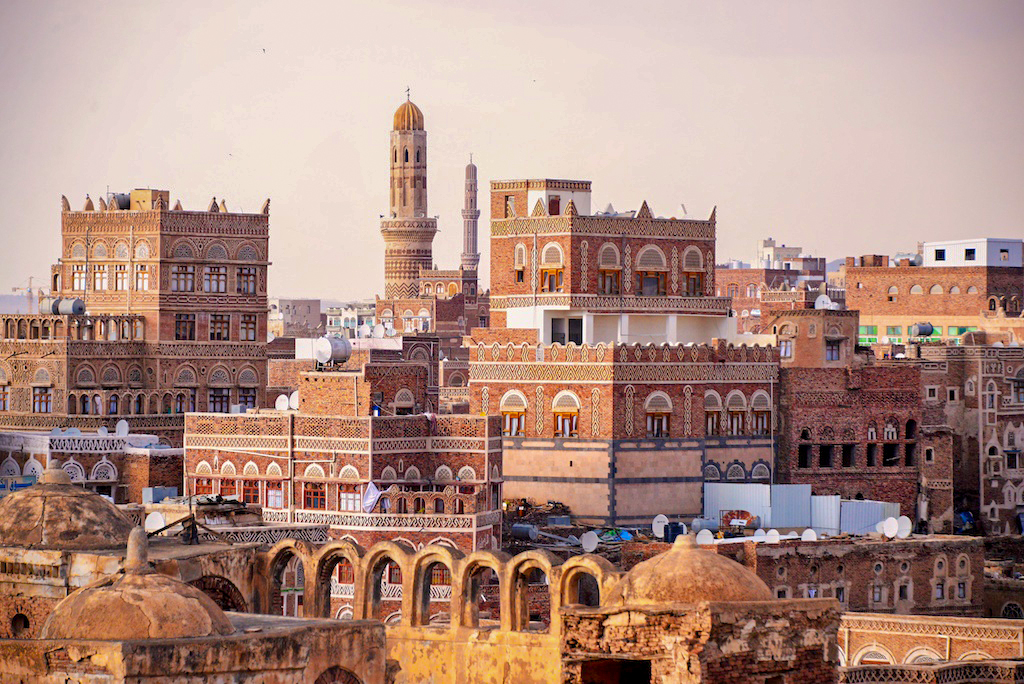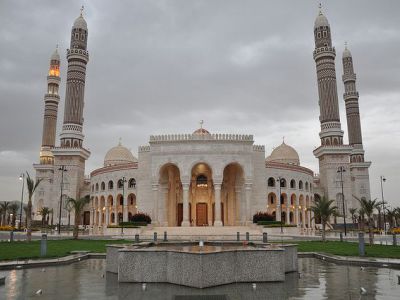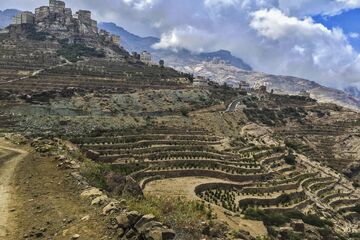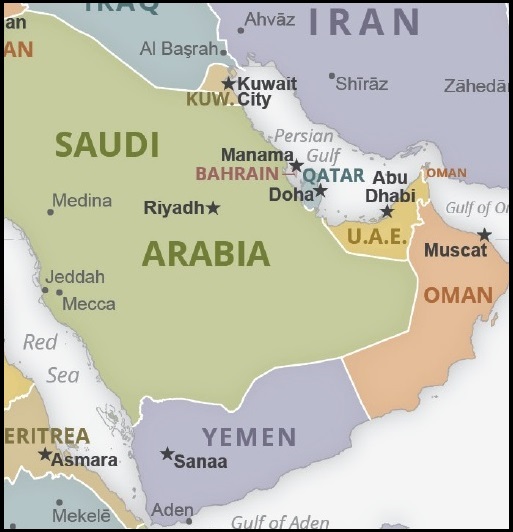The name Yemen is thought to be related to the word Yamnat, which probably referred to historical Yemen, which was much larger than what it is today. It may derive from the word ymnt, meaning “south,” or from the word yamn/yumn meaning “felicity” or “blessed” due to the fertile lands.
Yemen is located on the southern end of the Arabian Peninsula. It’s bordered by Saudi Arabia to the north and Oman to the east. It also has a coastline along the Gulf of Aden to the south and the Red Sea to the east. It’s directly across the water from Eritrea, Djibouti, and Somalia on the Horn of Africa. There are also several islands that belong to Yemen as well, many of which are volcanic. The areas close to the Saudi border are largely desert but the interior is quite mountainous. However, the western highlands are ideal for agriculture. Because of its elevation, much of the country enjoys cooler temperatures than the rest of the peninsula. The western coastal plains are more of a tropical climate, and there’s more rainfall there and many areas of the country except in the desert areas, especially the northeast corner.
 |
| The Queen of Sheba |
Yemen has a strategic location right in between eastern and western civilizations, and people have been living in this area for thousands and thousands of years. The Sabaean Kingdom was one of the first main kingdoms, making its entrance around the 11th century BCE. Saba was one of a few other kingdoms that were in this area; it was also thought to be Sheba (with its famous queen) that was mentioned in the Bible. The Sabaeans set up the foundations for key trade routes. The Romans explored the area, named it, and then left it in pieces. Much of the early centuries AD were spent fighting over borders and the spreading of Christianity and Judaism. But by the mid-600s, Islam became the major religion of this region. Several dynasties ruled Yemen during the period of around 1000-1500, each with its own battles, revolutions, and advancements. By the 1600s, the Ottomans began to really act on their interest in Yemen and the Arabian Peninsula: namely, their interest in Mecca and Medina (in current-day Saudi Arabia) and the key trade routes established from Yemeni ports. There was a lot of resistance as they moved into some areas (especially the highlands areas), which seems to last a long time. However, they were finally ran out of Yemen in the 1630s, right around the time that Yemen was the sole producer of coffee in the world. As the British were busy transporting Asian spices back to Europe, they became interested in Yemeni ports since the British had a strong naval background. They butted themselves into an incident that allowed them to take over the port of Aden, which really ticked off the Ottomans. The Ottomans tried to retake Sana’a but failed, and the opening of the Suez Canal made them determined to stay. The Ottomans were still hellbent on controlling the tribal regions of the highlands and failed again at trying to accomplish colonialism, this time leaving for good in 1918. The British controlled several colonies and protectorates in this area, including Aden. The North Yemen Civil War that took place during most of the 1960s convinced many to rise up against the British, but it also divided the country into two. By 1990, they came to an agreement and joined the two countries together again. But it didn’t take long before another civil war broke out in 1994. In 2000, an attack on the USS Cole in Aden set tensions on edge (claimed to be launched by al-Qaeda), although Yemen assured the US they were with us in the fight against global terror. Even as of a few years ago, al-Qaeda has been strong in Yemen (no doubt taking advantage of the political instability), and the country is once again in the midst of a civil war. The country is now plagued with lack of infrastructure, cholera, and starvation.
 |
| Sana'a |
In a lot of resources, the capital of Yemen is Sana’a (sometimes spelled as Sana). However, after Sana’a was occupied by the Houthis, the capital was temporarily moved to Aden in 2015. The old sections of Sana’a was declared one of the UNESCO World Heritage Sites and home to the Al Saleh Mosque. It’s the largest city in the country with a population of around 2.5 million people and also one of the highest in elevation. The port city of Aden is located on the southeastern shore, and although it’s smaller than Sana’a, they still have a population of around 863,000 people.
 |
| Port city of Aden |
Yemen highly depends on the services sector to bolster its economy. They also have strong footholds in food processing, textiles, oil refining, commercial ship repair, and natural gas production. Because of its landscape, agriculture is limited, but it’s there. Crops like sorghum, cotton, mangoes and other fruits, and khat are grown in Yemen but generally go back to supporting its own people. However, rising food costs are a growing concern. Their biggest exports tend to be coffee, natural gas, crude oil, and dried/salted fish.
 |
| Al Saleh Mosque, Sana'a |
Not surprising, Islam is the state religion of Yemen, with slightly more Sunni than Shia (55% to 45%), but other sects/denominations are included as well. There are also a small number of Christians in Yemen still and very few Jews are left in the country.
Officially, Modern Standard Arabic is the language used in Yemen, but it’s only used for written materials mainly. Yemeni Arabic is the variety that is spoken there. Mehri is a South Semitic language that’s also spoken in Yemen, and the Soqotri language is spoken on the island of Socotra. Other old languages originated here that had its influences throughout the Arab world. English is one of the more important foreign languages studied and used here because of its ties to Britain, but there are also pockets of Russian speakers.
 |
| Yemeni-brewed Seera Beer (the label says this is brewed in Aden) |
For most countries that declare Islam a state religion, there’s also a ban on alcohol. And that’s mainly true for Yemen, except that I read it’s not quite true about Aden and Sana’a, where people apparently drink like a fish. Or sailors. Beer is the main thing drunk there, but they do have a zero tolerance on drunk driving and public intox. They also smoke a lot too: I read the average adult smokes 34 cigarettes a month (considering that there are probably many people who don’t smoke at all, those who do must smoke like chimneys to keep the average up). Nearly one-third of the population suffers from malnutrition, and heart disease is a major killer. The statistics can be staggering, so it’ll be key to remember that it doesn’t quite paint the picture of this country, and I’m determined to see this country in a different light, from a cultural point of view.
Up next: art and literature



No comments:
Post a Comment